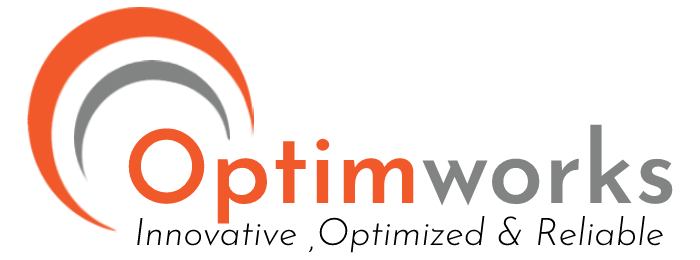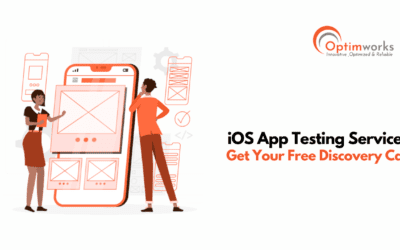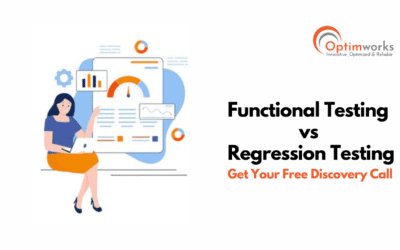Introduction
Software success isn’t measured by how well it passes internal QA alone—it’s judged by how end-users experience it in the real world. That’s where User Acceptance Testing services come in. UAT ensures that a product doesn’t just “work,” but works for the people it was built for—your customers, employees, and stakeholders.
Yet, many organizations confuse UAT with functional or regression testing, leading to gaps that surface only after launch. The result? Delayed rollouts, frustrated users, and rising support costs.
With modern applications evolving faster than ever, skipping UAT is no longer an option. It’s the final checkpoint where business goals and user expectations align.
At Optimworks, we deliver structured UAT services that reduce risk, accelerate adoption, and validate business value—helping enterprises launch software with confidence and measurable impact.
What Exactly are User Acceptance Testing Services?
User Acceptance Testing (UAT) services focus on validating whether a software product truly meets business requirements and user expectations before it goes live. Unlike functional or regression testing, which emphasize technical correctness, UAT centers on the end-user perspective.
In UAT, real business users or a representative group test the application in an environment that mirrors production. The goal isn’t just to confirm features work—it’s to ensure workflows, usability, and business processes align with actual day-to-day use.
For example, in a banking app, UAT doesn’t stop at verifying that “fund transfer” works. It checks whether customers can complete a transfer seamlessly, with the right validations, alerts, and compliance checks in place.
Effective UAT services cover:
- Requirement traceability and business validation
- Usability and accessibility checks
- Cross-platform, real-world scenario testing
- Compliance verification for industry standards
At Optimworks, we deliver UAT services with domain expertise in BFSI, healthcare, retail, and SaaS. Our approach ensures software launches are not only defect-free, but also adoption-ready and business-driven.
Core Components of UAT Services
Effective User Acceptance Testing services go beyond ticking boxes—they ensure your software meets real-world business needs. At Optimworks, our UAT approach blends structured processes, domain expertise, and automation where it adds value.
1. UAT Strategy & Planning
We begin by defining the scope, objectives, and success criteria of UAT. This ensures stakeholders and end-users know exactly what to validate and how outcomes will be measured.
2. Test Case & Scenario Creation
Optimworks crafts user-centric test cases reflecting real workflows. Scenarios simulate daily operations—whether it’s a retail checkout, a healthcare patient flow, or a banking transaction—ensuring business goals are validated.
3. Environment Setup & Data Preparation
We replicate production-like environments with realistic datasets, so tests reflect actual conditions. This reduces false positives and ensures meaningful results.
4. Execution & Stakeholder Involvement
Real users, SMEs, and QA teams collaborate to execute tests. Continuous feedback loops allow rapid identification and resolution of issues.
5. Defect Tracking & Reporting
All findings are logged, prioritized, and tracked to resolution. Detailed reports provide actionable insights for stakeholders and guide final release decisions.
6. Sign-Off & Release Readiness
UAT concludes with a formal acceptance sign-off, confirming the software is ready for deployment.
By combining these components, Optimworks ensures reliable, user-approved software, minimizes post-launch defects, and accelerates adoption across BFSI, healthcare, retail, and SaaS applications.
Benefits of User Acceptance Testing Services
Investing in User Acceptance Testing services delivers more than defect detection—it ensures business value, operational efficiency, and user satisfaction. At Optimworks, our UAT services are designed to validate software from the user’s perspective, bridging the gap between technical success and real-world adoption.
Key Benefits:
- Reduced Post-Launch Defects: UAT identifies issues before production, preventing costly fixes and downtime.
- Enhanced User Satisfaction: Validating workflows with real users ensures software is intuitive, functional, and aligned with expectations.
- Business Goal Alignment: Confirms that features support actual business processes, regulatory compliance, and strategic objectives.
- Faster Adoption: Smooth user experience increases confidence among employees or customers, accelerating usage and ROI.
- Lower Risk: Detecting gaps early minimizes operational, financial, and reputational risks, especially in high-stakes domains like BFSI and healthcare.
- Measurable Outcomes: Structured UAT provides actionable insights, improving future development cycles and continuous improvement initiatives.
Optimworks combines domain expertise, real-world testing scenarios, and structured reporting to maximize these benefits. Our clients experience faster go-lives, fewer production incidents, and higher user confidence—turning UAT from a checklist activity into a strategic advantage.
Common Challenges in UAT & How to Avoid Them
Even the best software can face hurdles during User Acceptance Testing. Recognizing these challenges early ensures UAT delivers real business value.
1. Ambiguous Requirements
Unclear acceptance criteria can lead to incomplete testing or misaligned outcomes.
Solution: Optimworks works closely with stakeholders to define precise, testable requirements before execution.
2. Limited User Involvement
Insufficient participation from actual users or subject matter experts can cause missed defects.
Solution: Engage representative end-users throughout UAT to validate real-world scenarios.
3. Environment & Data Issues
Discrepancies between test and production environments, or unrealistic datasets, can generate misleading results.
Solution: Optimworks sets up production-like environments with accurate, privacy-compliant test data.
4. Time Constraints
Rushed testing often skips critical workflows.
Solution: We employ prioritized test cases and structured execution to balance thoroughness with timelines.
5. Inefficient Feedback Loops
Slow defect reporting delays resolution.
Solution: Optimworks integrates collaborative tracking tools for real-time issue resolution and reporting, ensuring smooth stakeholder communication.
By addressing these challenges proactively, Optimworks ensures UAT is efficient, reliable, and aligned with business goals, enabling software releases that are ready for adoption and user satisfaction.
UAT Tools, Automation & Best Practices
Successful User Acceptance Testing services combine the right tools, selective automation, and structured best practices. While UAT often relies on manual execution to replicate real user interactions, strategic automation accelerates repetitive tasks and enhances accuracy.
Key Tools:
- Test Management Platforms: Jira, TestRail – organize test cases, execution, and reporting.
- Collaboration Tools: Confluence, Slack – enable seamless communication between QA, business users, and stakeholders.
- Issue Tracking: Bugzilla, Jira – for logging, prioritizing, and tracking defects efficiently.
- Automation Tools: Selenium, Appium – handle repetitive functional validations, freeing users to focus on real-world scenarios.
Best Practices:
- Define Clear Acceptance Criteria: Ensure test cases are measurable and aligned with business objectives.
- Engage Real Users: Involve representative end-users to validate workflows and usability.
- Use Production-Like Data: Test in environments mirroring live systems to avoid false positives.
- Prioritize Critical Scenarios: Focus on high-impact workflows first to reduce risk.
- Integrate Feedback Loops: Immediate reporting and resolution maintain test momentum and accuracy.
Optimworks applies these practices in every engagement, combining domain expertise, structured processes, and modern tooling to deliver reliable, user-approved software that reduces post-launch issues and maximizes adoption.
How Optimworks Adds Value
Not all User Acceptance Testing services are created equal. At Optimworks, we combine domain expertise, structured processes, and technology-driven approaches to deliver UAT that not only validates software but ensures business readiness.
Domain-Aware Expertise
Our team has extensive experience across BFSI, healthcare, retail, and SaaS. We understand industry regulations, compliance requirements, and business processes—ensuring your UAT is aligned with both technical and organizational expectations.
End-to-End UAT Coverage
Optimworks provides a complete UAT framework: from requirement analysis and test scenario creation to execution, defect tracking, and stakeholder sign-off. We focus on business-critical workflows, usability, and real-world scenarios to minimize post-launch issues.
AI-Powered Test Automation
Where repetitive validations are required, our AI-driven automation accelerates test execution without compromising accuracy. This enables faster feedback loops, reduced manual effort, and timely releases.
Continuous Monitoring & Integration
UAT is embedded into CI/CD pipelines, ensuring that updates, patches, and enhancements are validated continuously. Our dashboards track progress, highlight defects in real-time, and facilitate rapid corrective action.
Measurable Outcomes
With Optimworks, you see tangible results: fewer production defects, faster go-lives, increased adoption, and improved ROI. Our risk-free pilot programs let you validate the UAT approach on your software before full-scale engagement.
By partnering with Optimworks, enterprises gain trustworthy, business-ready software that meets user expectations and drives strategic outcomes.
Case Study: User Acceptance Testing in Action
A leading BFSI client approached Optimworks to ensure their digital banking platform was ready for a nationwide launch. With multiple modules—account management, fund transfers, loan applications, and bill payments—any defect could impact millions of users and regulatory compliance.
Optimworks implemented a structured User Acceptance Testing approach:
- Requirement Analysis: Mapped business objectives to test scenarios.
- User-Centric Test Cases: Created workflows reflecting real customer journeys.
- Environment Setup: Mirrored production conditions with realistic data.
- Execution & Reporting: Involved end-users, SMEs, and QA teams to validate all critical processes.
The results were impactful:
- 95% of critical workflows validated without post-launch defects
- User adoption accelerated by 30% due to intuitive, error-free experience
- Compliance with RBI and PCI-DSS verified before launch
- Faster decision-making with actionable insights for stakeholders
This case exemplifies how Optimworks’ UAT services combine domain expertise, real-world testing, and structured processes to deliver software that’s business-ready, compliant, and user-approved, reducing risk and accelerating ROI.
Conclusion
User Acceptance Testing services are the bridge between software development and real-world usability. They ensure that applications are not just technically sound but also aligned with business goals, user expectations, and compliance requirements. Skipping UAT can result in post-launch defects, frustrated users, and lost revenue—risks that no enterprise can afford.
Optimworks delivers end-to-end UAT services combining domain expertise, structured test frameworks, AI-assisted automation, and CI/CD integration. Our approach ensures that critical workflows are validated, defects are minimized, and software is ready for adoption from day one.
Whether you operate in BFSI, healthcare, retail, or SaaS, Optimworks helps you accelerate releases, reduce risk, and maximize ROI.
Ready to launch software your users will love? Partner with Optimworks for risk-free UAT services and ensure every release is business-ready and user-approved.




